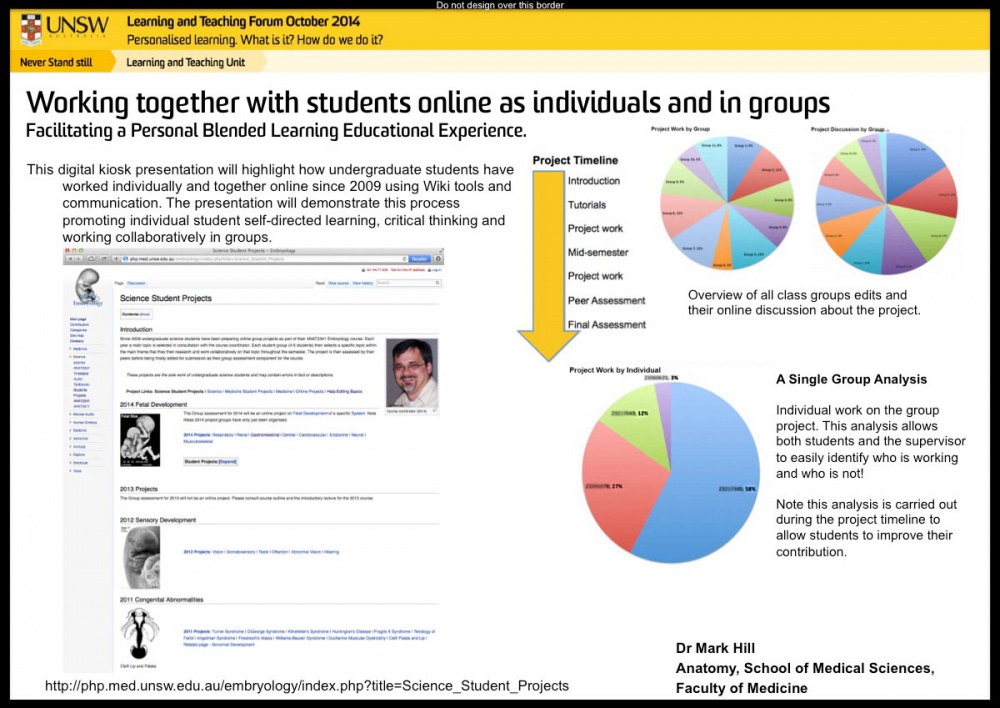Learning and Teaching Forum 2014 - Personalised Learning: Difference between revisions
mNo edit summary |
mNo edit summary |
||
| Line 4: | Line 4: | ||
This digital kiosk presentation will highlight how undergraduate students have worked individually and together online since 2009 using Wiki tools and communication. The presentation will demonstrate this process promoting individual student self-directed learning, critical thinking and working collaboratively in groups. Students initially personalise their learning experience by “owning their own content” and allowing their peers to see how they work. This open online environment establishes a level playing field, allowing students to not only submit their own work, but also observe how other students perform on the same tasks. How does personalised learning work in the online group-learning environment? For the first time a group project can be dissected by individual contributions, students are therefore “personalised” by knowing their contribution counts. In the group work a peer assessor process allows individual students to provide their own feedback and assessment of other group prepared projects. A valuable aspect of the entire online learning process is that students own, identify, interact with peers and still remain anonymous, being identified only by their student number. This allows individual students to safely personalise their online learning experience. | |||
This digital kiosk presentation will highlight how undergraduate students have worked individually and together online since 2009. The presentation will demonstrate | |||
Reference: | Reference: | ||
| Line 18: | Line 16: | ||
---- | ---- | ||
[[File:Learning_and_Teaching_Forum_2014_-_MH_Poster.jpg|1000px]] | |||
[[Media:Learning_and_Teaching_Forum_2014_-_MH_Poster.pdf|Poster PDF]] | |||
{{Footer}} | {{Footer}} | ||
Revision as of 10:50, 19 September 2014
Working together with students online as individuals and in groups
Dr. Mark Hill, Anatomy, School of Medical Sciences.
This digital kiosk presentation will highlight how undergraduate students have worked individually and together online since 2009 using Wiki tools and communication. The presentation will demonstrate this process promoting individual student self-directed learning, critical thinking and working collaboratively in groups. Students initially personalise their learning experience by “owning their own content” and allowing their peers to see how they work. This open online environment establishes a level playing field, allowing students to not only submit their own work, but also observe how other students perform on the same tasks. How does personalised learning work in the online group-learning environment? For the first time a group project can be dissected by individual contributions, students are therefore “personalised” by knowing their contribution counts. In the group work a peer assessor process allows individual students to provide their own feedback and assessment of other group prepared projects. A valuable aspect of the entire online learning process is that students own, identify, interact with peers and still remain anonymous, being identified only by their student number. This allows individual students to safely personalise their online learning experience.
Reference:
Online Presentation - http://goo.gl/J1Jt8f
- Embryology projects http://php.med.unsw.edu.au/embryology/index.php?title=Science_Student_Projects
- Cell Biology projects http://php.med.unsw.edu.au/cellbiology/index.php?title=Science_Student_Projects
Cite this page: Hill, M.A. (2024, June 2) Embryology Learning and Teaching Forum 2014 - Personalised Learning. Retrieved from https://embryology.med.unsw.edu.au/embryology/index.php/Learning_and_Teaching_Forum_2014_-_Personalised_Learning
- © Dr Mark Hill 2024, UNSW Embryology ISBN: 978 0 7334 2609 4 - UNSW CRICOS Provider Code No. 00098G

